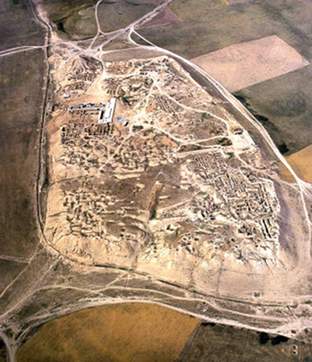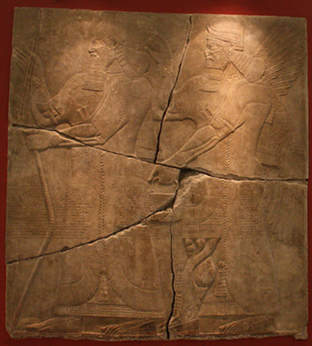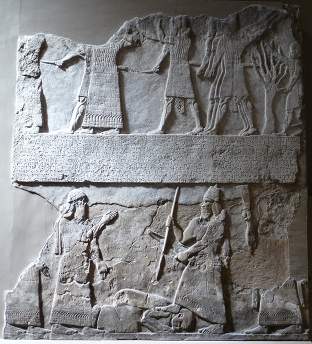Kalhu, Tiglatpileser's royal residence city
Assurnasirpal II (883-859 BC) moved the Assyrian court away from Assur to Kalhu, and this city subsequently served as Assyria's administrative centre and the king's main residence until Sargon II (721-705 BC) built the new city of Dur-Šarruken to fulfil these functions.
An ancient Northern Mesopotamian centre ...

Arial photograph of the citadel mound of Kalhu, modern Nimrud. View large image on aina.org website.
In the first millennium BC, Kalhu (modern Nimrud) was one of the most important cities of the Assyrian Empire. But the site was already inhabited in the 6th millennium BC and, from at least the early second millennium BC, was one of the foremost north Mesopotamian centres, then known under the name Kawalhum or Kawilhum. In the later second millennium BC, Kalhu was the capital of a province of the Middle Assyrian kingdom – a status which the city held until the collapse of the Assyrian Empire at the end of the 7th century BC.
Subsequently, the site was not completely abandoned but, while there is evidence for its continued habitation until the Hellenistic period, Kalhu was no longer an important city: when Xenophon and his Greek mercenaries passed by the site, then known as Larissa, at the close of the 5th century BC, it lay in ruins and was inhabited only by squatters who had taken refuge in the remains of what must be the ziggurat of the Ninurta temple.
Kalhu is situated in the centre of a triangle formed by the three most important cities of central Assyria: Assur in the south, Nineveh in the north and Arbela in the east. The city lies on the eastern bank of the Tigris, near the convergence with the Greater Zab, and held an important position in the long distance traffic network, both over land and on the rivers. Not only was it an important stop on the north-south route along the Tigris, it also controlled a key route leading east via Arbela towards the Zagros Mountains and, along their western fringes, south into Babylonia.
... transformed into the main royal residence by Assurnasirpal II

Detail of the wall decoration of Assurnasirpal's palace at Kalhu showing the king and a protective deity. Now in the Hermitage, St Petersburg; photo by Dieter Radner. View large image.
Until the reign of Assurnasirpal II, the religious and ideological centre of Assyria, the city of Assur, served also as the king's main residence. Assurnasirpal, however, relocated the entire royal court, moving hundreds of people under the supervision of his palace superintendent Nergal-apil-kumuya to Kalhu after this ancient city had been completely transformed. The old settlement mound, having grown to a substantial height in the course of its five thousand year long occupation, was turned into a citadel that housed only the royal palace and several temples of the most important deities of Assyria, such as Ninurta and Ištar – but not a shrine for Aššur, whose only sanctuary remained in the city of Assur. The citadel was protected by its own fortification walls but occupied only a small part in the south-western corner of the larger city: with a size of about 360 hectares, Assurnasirpal's Kalhu covered twice the area of Assur and was surrounded by a 7.5 km long fortification wall.
We do not know why Assurnasirpal moved the court away from Assur. Was the construction of the new city an exercise in conspicuous consumption, designed to show off Assyria's wealth to the world? Was Assur becoming too small for the ever-growing royal court and its agricultural hinterland too limited to support it? Did Assurnasirpal mean to distance himself from the old aristocratic families of Assur? Or was he trying to establish the king, rather than god Aššur, as the nucleus of the state?
Whatever the reason, Kalhu's most impressive building at the time of Assurnasirpal was certainly his new royal palace. At 200 metres long and 130 metres wide, it dominated its surroundings and its position on the citadel mound led to its modern name, the Northwest Palace. It was organised around three courtyards, accommodating the state apartments, the administrative wing and the private quarters which also housed the royal women. Here, several underground tombs were uncovered in 1989, including the last resting place of Assurnasirpal's queen Mullissu-mukannišat-Ninua, the daughter of the king's cupbearer, one of the foremost officials at court. Her rich burial goods give a vivid impression of the luxury in which the king and his entourage lived.
Kalhu in the 8th century BC

Stone slab of the wall decoration of Tiglatpileser's palace at Kalhu, showing the submission of a foreign king, probably Hanunu of Gaza, to Tiglatpileser in the lower register and Assyrian soldiers at war in the upper register; the inscription gives an account of Tiglatpileser's second campaign in the year 744 BC. British Museum, WA 118933; photo by Karen Radner. View large image.
Kalhu served as the main residence of all Assyrian kings up to Tiglatpileser III (744-727 BC) but, while Assurnasirpal's palace was not abandoned, several of his successors built their own palaces in Kalhu, among them Adad-nerari III (810-783 BC), whose palace was excavated by an Iraqi team in 1993, and also Tiglatpileser. The stone parts of their buildings as well as of the Northwest Palace were later ransacked to provide building materials for a palace of Esarhaddon's which remained unfinished but holds an important position in the history of Near Eastern architecture as a result of its columned halls.
Tiglatpileser's palace is known today as the Central Palace but its ancient name was "Palaces of joy which bear abundance (and) bless the king who made their structure everlasting". The ceremonial name given to the palace gateway makes it clear that the king saw Kalhu not just as the centre of Assyria but of the entire world: "Gates of justice which pass fair judgement on the rulers of the four corners (of the world), which offer the tribute from the mountains and the sea, which admit the produce of mankind before the king, their lord". Parts of the wall decorations of Tiglatpileser's palace are today housed in the British Museum.
While excavations in the course of the 19th century resulted in the discovery of only a single cuneiform tablet (presumably because unfired clay tablets were not recognised by excavators), Kalhu yielded a number of important textual finds in the 20th century, with the discovery of the so-called Nimrud Letters in 1952 constituting a particular highlight. These 240 or so letters form part of the royal correspondence and cover the reign of Tiglatpileser III and the first years of Sargon II as king of Assyria. Although it is likely that some of the material should be dated to the brief reign of Tiglatpileser's successor Shalmaneser V (726-722 BC), only those letters which he wrote as crown prince (under his birth name Ululayu) can be attributed to him with certainty. The Nimrud Letters were found in Room ZT of the Northwest Palace which, while no longer the king's main residence, continued to serve the state administration and also functioned as the burial place of the queens of Tiglatpileser III, Shalmaneser V and Sargon II.
Further reading:
Curtis, 'New Light on Nimrud', 2008.
Oates and Oates, 'Nimrud: an Assyrian imperial city revealed', 2001.
Postgate and Reade, 'Kalhu', 1977-80.
Content last modified: 20 Jul 2021.
Karen Radner
Karen Radner, 'Kalhu, Tiglatpileser's royal residence city', Assyrian Empire Builders, University College London, 2021 [http://oracc.museum.upenn.edu/saao/aebp/essentials/cities/kalhu/]